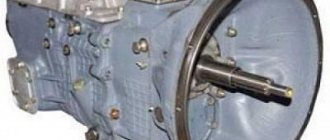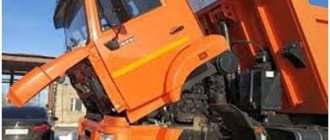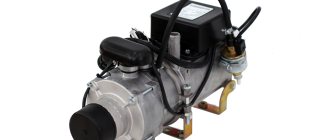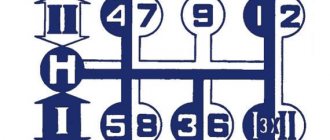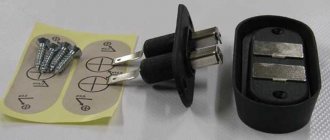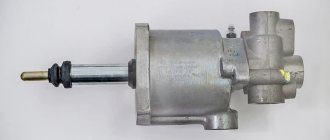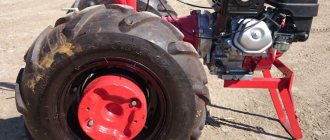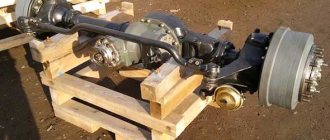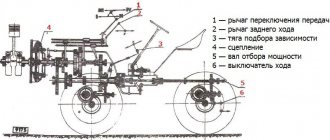1. The transfer case is in neutral.
Rice. 84. Locking device: 1 — overdrive engagement rod; 2 — downshift rod; 3— plunger; 4 — locking device body; 5 - ball
The three-position switch is set to position H. The electro-pneumatic valve is turned on, and compressed air is supplied to the downshift pneumatic chamber. Under the influence of compressed air pressure, the diaphragm of the pneumatic chamber bends, the rod with the fork and the clutch move, and the downshift is turned off. No torque is supplied to the differential housing.
The neutral in the transfer case is turned on when the vehicle's winch is in place.
2. Overdrive is engaged, the differential is unlocked.
The three-position switch is set to position 11. Both electro-pneumatic valves are turned on, compressed air is supplied to both pneumatic chambers. First, the downshift is turned off, and then the upshift is turned on. The diaphragm of the pneumatic chamber bends, the rod with the fork and the coupling move. The clutch connects the overdrive gear to the carrier (differential housing). The differential lock valve is set to the DIFFERENTIAL UNLOCKED position.
Torque is transmitted from the gearbox through the cardan transmission to the transfer case input shaft, from the input shaft through the key to the input shaft gear, through the intermediate shaft gear to the overdrive gear, through the clutch to the carrier, from the carrier to the satellites, then to the sun and epicyclic gears, from the sun gear to the front axle drive shaft, from the epicyclic gear to the rear axle drive shaft. Torque is divided in a ratio of 1:2.
3. Overdrive is engaged, the differential is locked.
In this case, the lock activation valve is set to the DIFFERENTIAL LOCKED position.
Compressed air from the pneumatic system through a valve through pipelines enters the differential lock pneumatic chamber. The diaphragm bends and moves the rod with the fork, the fork moves the clutch. The clutch moves rearward and connects the front axle drive shaft and the differential housing. In this case, the sun gear becomes locked to the housing and the differential rotates as one unit. The torque is divided depending on the grip of the wheels on the road.
4. Downshift is engaged, the differential is unlocked.
The three-position switch is set to position 1.
This turns off the current in the coils of the electropneumatic valves, which are set to their original position by the action of the armature springs. The intake valve closes, the exhaust valve opens. Compressed air from the gearshift pneumatic chambers escapes into the atmosphere. Under the action of the return springs of the pneumatic chambers, the overdrive gear is first switched off, and then the downshift is switched on. The clutch connects the idler gear to the reduction gear.
The differential lock valve is set to the DIFFERENTIAL UNLOCKED position. Torque is transmitted to the transfer case input shaft, from the input shaft through the key to the input shaft gear, then through the countershaft gear and clutch to the reduction gear, and then to the differential drive gear and carrier. From the drive to the satellites, then to the sun and epicyclic gears. The differential distributes torque in a ratio of 1:2.
5. Downshift is engaged, the differential is locked. In this case, the differential lock activation valve is set to the DIFFERENTIAL LOCKED position. Compressed air from the pneumatic system through a valve through pipelines enters the differential lock pneumatic chamber. The diaphragm bends, moves the rod with the fork, and the coupling. The clutch connects the front axle drive shaft to the carrier. In this case, the sun gear becomes locked to the differential housing. The drive shafts of the front and rear axles rotate as one unit. Torque is distributed depending on the grip of the wheels on the road. In this case, the car has the highest cross-country ability.
The transfer case is splash lubricated. The downshift gear bearing is lubricated by gravity from an oil sump connected through channels in the crankcase, bearing cap, fitting, shaft with the bearing area.
The KAMAZ 43118 vehicle is designed for off-road driving. The price of high cross-country ability is the complicated design of the torque transmission system between the axles and the engine. To evenly distribute the load and coordinate the torque, a transfer case is provided on the chassis of the machine. The worse the quality of the road surface, the faster its parts wear out. At the same time, the box itself is completely repairable, it is only important not to lose sight of the primary signs of malfunctions and immediately begin repairs.
Signs of malfunctioning KAMAZ transfer case
The transfer case, like most parts in the design of a truck, does not give itself away until something breaks in it. In 85% of cases, breakdowns are associated with current wear and tear, and only in 15% with mechanical breakdowns caused by external factors or improper operation of the unit. In order to pay attention to malfunctions in time, you need to carefully monitor the following factors:
presence of extraneous noise while the vehicle is moving;
random switching off of gears;
wedges or jamming of the lever;
damage to the transfer case.
The problems listed above appear not only on KAMAZ trucks. Trucks of other brands equipped with a transfer case exhibit the same problems.
Instructions
Now we suggest you find out how to start and in what sequence to correctly engage the gears on a KAMAZ gearbox. There are certain features in this process, and the procedure for changing gears differs from passenger cars.
Start of movement
You need to know how to change gears on a KamAZ. The KamAZ truck should start moving at a reduced speed. Please note that when driving away, the gear shift is carried out with the clutch disengaged. In KAMAZ gearboxes, the switching scheme is carried out in several stages, this is due to the peculiarities of increasing and decreasing speeds.
How to turn on the speeds on KamAZ:
- The truck can drive quickly on different types of roads, but at the first stage, in accordance with the diagram, it is recommended to start driving in gear 1B.
- After this, 2V transmission is switched on.
- At the final stage of starting from a standstill, speed 3B is switched on.
In accordance with this traffic pattern, the vehicle starts at a reduced speed. That is, the shift lever on the box does not need to be touched until fourth gear. To start moving, you need to increase the crankshaft speed to about seven thousand revolutions (the author of the video lesson on how to switch gears on a KamAZ truck is Nikita Vagin).
Switching speeds
Now we’ll tell you how the gearbox on a KamAZ is switched when the car starts moving. When the car accelerates, the gear shift order on KamAZ is as follows - 4N-4V-5N. To activate the second speed, the crankshaft speed must increase to three thousand revolutions according to the tachometer. Please note that the operation of the crankshaft plays a major role. By changing gears correctly, you can achieve savings in fuel consumption. In this case, the most economical operation of the motor without downtime will be achieved.
Reverse
As for reverse, according to the diagram, to activate it, you need to set the switch to the lower left position. Activating reverse gear is not allowed while driving. To engage reverse, stop the vehicle completely and then perform the maneuver.
Causes of breakdowns
| Cause of malfunction | Remedy |
| Vibration and noise in the gearbox | |
| Loose or damaged suspension, engine and transmission mounts | Tighten or replace supports |
| Worn or damaged gears and bearings | Have the gearbox repaired at a service center |
| Filled with oil of the wrong brand | Fill with oil of the appropriate brand |
| Insufficient oil level | Add oil to normal level |
| Violation of engine idle speed control | Adjust engine idle speed |
| Oil leak | |
| Destruction or damage to oil seals or O-rings | Replace seals or O-rings |
| Difficulty shifting gears and grinding noise when shifting | |
| Incomplete clutch disengagement | Remove air from the hydraulic drive disengaging the clutch |
| Malfunction of gearbox cables | Replace cables |
| Weakening the synchronizer springs | Have it repaired at a service center |
| Filled with oil of the wrong brand | Fill with oil of the appropriate brand |
| Spontaneous gear shutdown | |
| Worn gear shift forks or broken retainer springs | Have the gearbox repaired at a service center |
| Increasing the synchronizer clutch clearance on the hub | Have the gearbox repaired at a service center |
Service station mechanics identify the following most common causes of transfer case malfunctions:
breakage of one or more gear teeth;
wear or lack of lubrication of bearings;
formation of burrs on splines;
spatial deformation of sliders;
damage to the tightness of the diaphragms of pneumatic chambers;
looseness of butt joints of couplings.
Most of them are usually discovered during the operation of the vehicle. Even during routine technical inspection of the chassis and other components, people rarely look under the transfer case cover, and there is not always any point in this - more than half of the common breakdowns are not visually noticeable.
It is important to constantly pay attention to the behavior of the car, especially if it is frequently and actively used. If you overlook it and continue to drive with malfunctions, this is fraught with failure of the transfer case and, as a result, loss of controllability of the car.
The main malfunctions of the transmission of the KamAZ-4310 vehicle
Difficulty engaging all gears, engaging reverse gear and 1st gear with a grinding noise
caused by incomplete disengagement of the clutch (the clutch “drives”).
adjust the free play of the clutch release clutch.
Large force on the gear shift lever
caused by contamination of the remote control rod supports, lack or thickening of lubricant
the supports should be washed and filled with fresh lubricant
Shifting into 2nd - 5th gears with a bang and a grinding noise.
caused by wear of the synchronizer cone rings, blocking the chamfers of the fingers and the carriage, which reduces the force of moving the carriage out of the neutral position
eliminated by replacing the synchronizer.
Shifting gears in the divider with a bang and a grinding noise
may be caused by increased pressure in the pneumatic divider control system,
requires adjustment of the pressure relief valve,
may be caused by a rupture of the pressure reducing valve diaphragm,
requires its replacement
may be caused by wear of the synchronizer cone rings, blocking the chamfers of the fingers and the carriage,
requires synchronizer replacement
Wear of the divider shift fork cotters
may occur due to the lack of air discharge into the atmosphere when switching gears of the divider due to contamination of the air channels and the breather valve of the gear divider.
Disassemble the valve and thoroughly wash all its parts, including the breather. When assembling the valve, lubricant 158 is applied to all rubbing surfaces.
no gap between the synchronizer carriage and the gear shift fork holder
Self-switching of gears while the vehicle is moving.
occurs when the gear is not fully engaged due to a malfunction of the shift mechanism clamps, wear of the fork legs or nuts, loosening of the forks and remote control adjustment levers.
tighten fasteners, replace worn parts, adjust control drive.
The secondary shaft spline lock does not work.
requires replacement of the shaft and synchronizer.
Transmission does not start
when parts are worn out and the remote control drive of the gearbox is misaligned.
replace worn parts, tighten fasteners and adjust the drive.
destruction of secondary shaft gear bearings
Gears in the divider are not included
air distributor pistons jamming
the air distributor is disassembled, the parts are washed, and during assembly, lubricant 158 is applied to them.
the position of the stop of the divider activation valve is misadjusted
it is regulated. Broken stop being replaced
Divider control valve cable is broken
Increased noise during gearbox operation.
can be caused by wear or breakage of gear teeth, destruction of gear bearings and shafts
Defective parts are replaced
Oil leak from gearbox
wear or loss of elasticity of the seals
increased pressure in the crankcase
leakage of sealing surfaces
tightening fasteners or replacing gaskets
Wear of brass synchronizer rings of the main gearbox
occurs due to incomplete disengagement of the clutch when changing gears.
replace synchronizers and check the operation of the clutch and drive.
Worn brass rings of the gear divider synchronizer
occurs due to incomplete disengagement of the clutch when changing gears, as well as when misadjusting the position of the gear divider valve stop
after replacing the synchronizer, make the necessary adjustments.
Drive axle malfunctions
Increased circumferential clearance in the meshing of bevel gears
May be caused by wear on their bevel gear teeth.
replacing bevel gears.
May be caused by worn tapered roller bearings
by adjusting, restore the preload of the bearings and check the contact patch in the mesh of the gears
Increased noise when driving a car at a speed of 30.40 km/h
the contact patch is shifted towards the wide part of the driven gear teeth
requires adjustment of the engagement along the contact patch
Continuous whine when driving
insufficient oil level in the axle housing
establish oil leakage points (through oil seals or cover connectors), if necessary, replace oil seals and tighten the cover bolts, add oil to the specified level
wear or damage to gears and bearings.
gears and bearings are replaced.
lack of free play of the clutch release
adjust the free play of the clutch;
lubricant ingress on friction surfaces -
the clutch is removed from the engine and the friction surfaces are washed or the friction linings or driven disc assemblies are replaced;
wear or destruction of friction linings
replace linings or driven discs assemblies and adjust the clutch drive
reduction of pressure spring force
springs are replaced along with paronite pads
The clutch “drives” if the clutch drive does not provide the required stroke of the clutch fork shaft lever
air entering the hydraulic system, leakage of working fluid, increased free play
Warping of driven disks
Clutch drive jammed
when the hydraulic clutch seals swell and lose their tightness due to the use of non-recommended or contaminated brake fluids.
Replace brake fluids
Delay in clutch engagement when starting and changing gears
When the working fluid in the hydraulic system solidifies or its viscosity increases -
wash the hydraulic system of the clutch release drive and fill it with Neva brake fluid;
When the follower piston of the pneumatic booster is jammed
replace the piston cuff;
If there are burrs in the connections of the pressure and middle disks with the flywheel
working surfaces are ground and lubricated.
Increased clutch pedal effort
due to swelling of the inlet valve of the pneumatic booster, compressed air does not enter the system,
replacing the air booster inlet valve
due to swelling of the sealing collar or the rubber ring of the follower piston of the pneumatic booster, the piston is jammed
replacing the sealing collar or rubber ring of the air booster follower piston
The transfer case is controlled by a pneumatic valve, the handle of which is located on an additional panel under the instrument panel (see Fig. Transfer case gear shift valve handle).
Transfer case shift valve handle
The gear shift valve handle has three fixed positions, each of which corresponds to a transfer case gear: N – neutral. Bridges are disabled. I - the handle is turned to the right, the first (low) gear is engaged. At the same time, the downshift indicator light on the instrument panel lights up. Engage the first (lowest) gear before driving along difficult sections of the road, as well as when parking the car for long periods. II – the handle is turned to the left – the second (highest) gear is engaged. Engage the second (highest) gear before driving on paved roads.
Attention! You can change gears only after the car has come to a complete stop and with the gear shift lever in the neutral position in the gearbox. Engaging neutral in the transfer case while the engine is running and the gear in the gearbox is engaged is prohibited.
If the pneumatic system fails, it is possible to force a gear shift in the transfer case (see section 7 “Possible malfunctions of vehicle units and systems. Self-help”).
The transfer case center differential lock is controlled pneumatically by a handle located on an additional panel under the instrument panel. The lock should be turned on immediately before overcoming difficult sections of the route (sticky soil, obstacles, slippery muddy roads).
Attention! Activation of the transfer case center differential is allowed only after the vehicle has come to a complete stop and with the gear shift lever in the gearbox in neutral position. The transfer case center differential lock must be disabled immediately when driving onto a hard, dry road, since driving with the lock engaged on a hard road can lead to damage to the transfer case parts.
Handle for controlling the locking of the center differential of the transfer case
The tap handle has two fixed positions:
- locking enabled - right position 1;
- locking is off - left position 2.
When the lock is turned on, the indicator lamp for turning on the locking of the center differential of the transfer case alt="Warning lamp for turning on the lock of the center differential of the transfer case on a KamAZ" lights up on the instrument panel and lights up while the differential is locked. If the indicator light alt="Indicator light for turning on the center differential lock of the transfer case on a KamAZ" /> does not light up, you must:
- turn off the lock by setting the center differential lock control valve handle to position 2;
- carefully move the car forward 0.5-1 meter. If there is no traction, turn the drive wheels;
- turn on the locking by setting the tap handle to position 1. Then move away smoothly, without jerking, to reduce wear on the teeth of the locking clutch.
Attention! Driving a vehicle with the transfer case center differential lock engaged is only allowed when the warning light is on.
Transfer case
The KamAZ-4310, 43118 car is reliable and proven over long kilometers of Russian roads. It is believed that this is a car with increased cross-country ability, produced at the Kama Automobile Plant since the beginning of 1981. At first, these cars were supposed to be used for the needs of the Secular Army, but then they were firmly entrenched in the national economy. Now they are confidently winning competitions, proving the indisputable advantage of our cars.
Kamaz 4310
Rules for shifting gearboxes in different conditions
Knowing how to start and how to continue moving is not enough for the correct operation of the KAMAZ transmission. To avoid problems with the unit when using the gearbox, you must follow the rules. Errors made during operation can lead to serious malfunctions.
On the rise
How to change gears on a KamAZ when driving uphill
Driving a domestic truck when lifting must be done at increased speed. To switch from first to second speed, the driver needs to depress the clutch twice. Consider the fact that you must simultaneously press the gas pedal and the fuel pedal. These actions are important as they help stabilize the overall performance of the crankshaft. To avoid problems with the operation of the unit, you do not need to reduce the engine speed to less than two thousand when climbing. This will cause the car engine to turn off. Also, such driving increases the operating temperature of the power unit, and this can cause its breakdown.
When driving a car using this principle, you can achieve maximum directional stability. Thanks to the principle of dividing the transmission circuit into two modes, easier engine operation is achieved. Moreover, regardless of whether the car is loaded or not.
On the descent
If you are driving downhill, you do not need to turn off the engine. When the engine is turned off, the steering wheel will lock. And this will lead to an emergency on the road. When driving downhill, do not turn off the auxiliary braking, and also depress the clutch pedal all the way. Newer versions of trucks use improved transmissions, which has allowed engineers to reduce the load on the main gearbox parts. Therefore, when driving in critical conditions and on descents, the car’s engine will not wear out.
KamAZ vehicles use a double-boost braking system. That is, in addition to braking by the power unit, there is an additional engine stopping system. If you are driving downhill with active auxiliary braking, then you cannot disengage the clutch and change gears.
Schemes of the main and transfer cases on KamAZ
Icy areas
Driving a truck on icy areas should be done with the greatest reserve of speed and travel. When braking, use the active brake assist system. If emergency braking occurs, the driver must stop the trailer wheels. If you do not take this point into account, you will end up in a skid. It is recommended to slow down with the power unit only in exceptional cases. Because this leads to accelerated engine wear, but the braking distance is significantly reduced. When braking, do not allow the wheels to slip. To avoid this, you need to turn off the reduced speed in time, this will lead to a drop in crankshaft speed.
Skid
When skidding, follow the main rule - do not squeeze the clutch, otherwise this will worsen the situation. During the production of cars, engineers introduced a scheme due to which the car can drive with the greatest power reserve. Thanks to this, you can achieve course stabilization while driving on any road. If a skid occurs while driving, the steering wheel of the car must be turned in its direction. That is, if the car skids to the left, then the steering wheel also turns to the left.
If the truck begins to slip, then you need to stop moving as quickly as possible and immediately disable the differential axle. You can see the switch to turn it off on the dashboard. When the differential axle is disengaged, a corresponding indicator will appear on the instrument panel. After this, the start of movement is carried out at increased speed, from second gear. When you drive through a hard-to-reach section of the road, do not forget to engage the differential (video shot and published by Vladimir Nikonov).
Device
Moscow designers also took part in the creation of the KamAZ car. At the time of the creation of the car, an advanced principle for the interaction of drive axles was developed and implemented. This refers to a permanent drive, which has four cardan shafts.
At the same time, the transmission is equipped with a center differential, which is supported by electric and pneumatic locking. There are several modifications that have some differences, but they are not significant. The KAMAZ 4310, 43118 vehicle is equipped with a KAMAZ-740.10 engine, which has a power of 210 -220 hp.
The basic version of the KamAZ 4310 vehicle is characterized by a shorter platform with a voluminous awning and a tailgate that folds down. The body has a row of seats for 30 people, which can be transformed, that is, they are folding. Years of production: 1983-1990.
KamAZ-43118 has an enlarged platform, which has a significantly higher load capacity. This modification of the KamAZ car began to be produced in 1996.
One of the important parts of the car is the gearbox, namely the KamAZ transfer case; it disperses torque if the road is bad, and it is distributed between the axle of the front of the car and the rear of the truck. What is the purpose of the transfer case?
Need to replace bearings
Gearbox input shaft bearing
One of the reasons indicating that the bearings installed on the 154 KamAZ gearbox have become unusable is the appearance of a characteristic whistle when moving. Also, the clutch may not engage. The input shaft bearing must be inspected. Whistling can also occur when the mechanism is insufficiently lubricated.
If the bearing has cracks on its surface, the spare part must be replaced. If this component is destroyed, a characteristic knock will be heard when the vehicle moves.
Transfer case KAMAZ-4310,43118
Box device. The main components are the following:
- Carter;
- Main or drive shaft;
- Intermediate or secondary shaft;
- Shaft located on the front axle;
- Shaft for driving axles at the rear of the car;
- Shaft intended for power take-off;
- Center differential;
- Central control drive;
- The gear is responsible for overdrive.
The crankcase on the KAMAZ 4310.43118 motor vehicle is made as a cast structure on which a vertical connector is located. A power take-off box is installed on the upper section of the crankcase using a hatch. This is the structure of the box.
The crankcase is closed with a lid; the manufacturer provides for oil filling through this connector, which is closed with a plug. The driver can easily check the level of consumed oil; this can be done through the lower hole, which is also equipped with a magnetic plug. The crankcase is protected on top by a lid, that is, the crankcase hatch, and it is intended for power take-off.
The operation of the drive shaft involves two types of bearings: ball bearings (1 piece) and cylindrical roller bearings (2 pieces). The bearings located in front have a seal, and the rear bearing is located inside the crankcase, in a special compartment.
There is a gear on the shaft; it is not only a drive gear, but it is also pressed in, and the gear responsible for power take-off is already welded onto the hub.
The intermediate shaft moves thanks to bearings, both roller and cylindrical, which are protected by covers. The intermediate gear, as well as the first gear, are fixed to the shaft and move differently on it. From the oil sump, which is located above the intermediate shaft, oil flows onto the gear rollers by gravity. Both gears have teeth embedded in them, and it is on them that the clutch is attached, which is responsible for the first gear, and specifically for engaging it.
How does a center differential work? As you know, the wheels of the front axle and the wheels on the trolley spin differently, especially if the movement occurs on an unpaved road, on a country road, or equipped only with crushed stone backing. The differential distributes the torque between them in a percentage ratio of 1:2; it is installed at the very bottom of the crankcase on two bearings: roller and cylindrical. Also provided:
- Main, drive gear;
- Rear clip, and front;
- Solar, as well as in a pair of epicyclic gears;
- Satellites.
Both cages are fixed on the drive gear, while the sun gear is located on the splines of the front axle shaft, and the epicyclic gear is paired with the bogie shaft. The satellites are mounted on bushings made of bronze, in the front differential race and support washer. Their task is to always be in conjunction with the gears, as mentioned above with the solar and epicyclic ones.
On the holder in front there are two roller bearings, and the gear responsible for second gear also rotates there. A gear coupling helps connect to the front cage. The coupling allows you to lock the differential, and on the front shaft of the axle drive there is a gear to drive the sensor, which reflects the readings of the speedometer, which is located on the crankcase.
Using the switch, which is located in the driver's cabin, you can control the gearbox (RK), the system is responsible for this action, which includes a switch, electric pneumatic valves, two pneumatic chambers and pneumatic actuators, and a sensor responsible for switching on.
Specifications
The KamAZ gearbox with a divider includes the following elements:
- a crankcase in which the drive, driven and intermediate shafts assembled with gears are mounted;
- bearings;
- synchronizers,
- reverse gear block,
- top cover of the box,
- gear shift mechanism.
The gearbox of KamAZ vehicles can be five- or ten-speed. The gearbox divider has high and low gears and, in combination with the main gearbox, allows for 10 forward gears and 2 reverse gears. The divider system improves the traction qualities of the machine, makes it easier to control, and reduces the frequency of shifting gears with a lever. Transmission ratios are available in the operating instructions for the device.
The 141 KamAZ gearbox has a reversing light switch. To prevent the simultaneous activation of 2 gears, there is a ball-type lock in the cover, and a spring-finger fuse is used to prevent accidental engagement of reverse gear. The gearbox with divider weighs 320 kg. The cuffs are located in the shaft covers. They protect the gearbox from clogging and prevent oil leakage. Insufficient oil volume in the gearbox leads to its damage. When you first fill the gearbox there should be 9 liters of oil, when changing the fluid - 8 liters.
Technical characteristics of the KamAZ-141 gearbox:
- The diameter of the bearing bore is 150 mm.
- The diameter of the hole in the gear block axis is 32 mm.
- The diameter of the front bearing journal is 24 mm.
- Rear bearing - 59 mm.
The secondary shaft has the following diameters for the parts:
- Fourth gear gear bushings - 63 mm.
- Roller bearings - 80 mm.
- Reverse gear bushings - 70 mm.
- The outer diameter of the sleeve is 72 mm.
- The diameter of the front bearing journal is 65 mm, the rear one is 49 mm.
- The diameter of the rear bearing cup is 119 mm.
- The diameter of the intermediate shaft is 65 mm.
- The inner diameter of the gear is 65 mm.
The weight of the gearbox with divider is 320 kg.
How does a transfer case work?
Kamaz 4310 transfer case diagram
After turning on the switch, compressed air is not able to enter the pneumatic chambers, and therefore the diaphragms take their original position. The torque between the shaft gears is transferred to the races and satellites. The gears, carried by the satellites, allow you to move along a good, damage-free road as a single unit. If the road becomes uneven, for example, off-road, the front axle and the bogie move differently, and then the epicycle with the sun gear rotates at different speeds, and the satellites rotate not only around the main axis, but also around their own axes.
Both gears can turn on at the same time, and to prevent this, a lock is supposed to prevent this from happening. If we take into account the differential lock, then when locked, the pneumatic chamber moves the clutch, which serves as a connecting element between the cage and the drive shaft on the front axle. This allows you to move on roads of different quality, both good and poor quality, as a single mechanism, the torque is proportionally distributed between the front axle and the bogie, as are the loads on them.
To eliminate the load on the transmission, the differential is constantly active, that is, unlocked. Only in a situation where you are driving on slippery roads should you use a lock, as this reduces the risk of wheel slipping and guarantees the safe movement of the vehicle.
Lubricating the RK is quite simple. It is enough to spray the oil, and about five liters of oil of a certain brand are poured into the crankcase.
Switching rules under different conditions
Gear changes depend on the various conditions in which the vehicle is moving. These rules should be followed so that during the use of the gearbox it does not fail.
Climb
During an ascent, you must switch the gearbox to mode H, as a result of which the transmission will begin to operate at increased voltage.
The following rules must be followed:
- When switching from 1st to 2nd gear when ascending a KamAZ truck, you must use the method of depressing the clutch pedal twice.
- In order for the crankshaft to work correctly when changing gears, you need to use the fuel pedal; it also needs to be pressed periodically. At the same time, you can overcome any steepest climb.
- The shaft speed when lifting must be more than 2000 rpm. Otherwise, the engine may shut down, which may cause an accident while driving on the road.
- During the climb, switch to the desired mode, this will facilitate the operation of the engine and all components of the machine.
Descent
Some drivers turn off the engine when descending a mountain to save gas. This should not be allowed at KamAZ.
If you turn off the internal combustion engine during a trip, the electric booster will not perform its functions, which will lead to the steering wheel locking.
KamAZ braking occurs not only as a result of stopping the engine, but also by activating the auxiliary braking system. When a heavy vehicle is going downhill and the driver applies the auxiliary brakes, the clutch should not be depressed and the driver should not shift from one gear to another.
Icy areas
You need to drive a truck on icy areas with maximum speed and range. When braking, you must use the engine stop assist system. If emergency braking is required, the operator must stop the trailer wheels. If you do not take this rule into account, you may end up in a skid.
